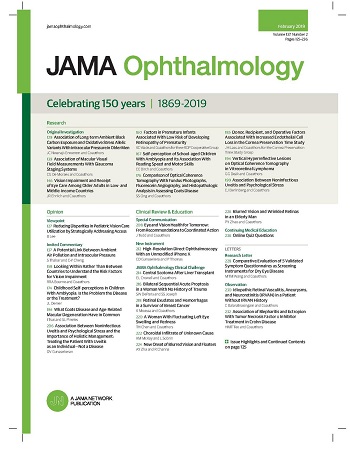Ophthalmic Knowledge Assessment Program Scores and Written Qualifying Examination Performance.
IF 9.2
1区 医学
Q1 OPHTHALMOLOGY
引用次数: 0
Abstract
Importance The Ophthalmic Knowledge Assessment Program (OKAP) has been widely used to determine readiness to take the high-stakes Written Qualifying Examination (WQE). However, it is unclear how well OKAP performance can predict WQE outcomes. Objective To examine the association between the OKAP and WQE nationally. Design, Setting, and Participants This was a retrospective cohort study conducted from 2017 to 2022. This national data analysis included residents from ophthalmology residency programs in the US. Study data were analyzed June 2023 to December 2024. Exposures OKAP and WQE data. Main Outcomes and Measures The national OKAP examination data and the WQE data were matched. Candidates who had complete data for the OKAP during postgraduate year (PGY) 2, 3, and 4 and completed the WQE were included in the study. Two-sample t tests, logistic regression analysis, receiver operating characteristic curves, and confusion matrix were used to examine the association of various test scores (PGY-2 OKAP, PGY-3 OKAP, PGY-4 OKAP, minimum OKAP, maximum OKAP, average OKAP) as predictors for WQE outcomes (pass or fail). Multiple logistic regression analyses were also used to assess the association of gender, time since graduation, program size, and WQE pass/fail outcomes. Results A total of 1597 residents (907 male [56.8%]) from 117 residency programs were included in this study. First-time pass rate of the WQE was 89% (1418 of 1597 residents). OKAP scores, particularly average OKAP, maximum OKAP, and PGY-4 OKAP scores (all had area under the curve = 0.88), were the most useful predictor of WQE outcomes. PGY-4 OKAP scores were used for the rest of the analysis for simplicity. A PGY-4 OKAP scaled score of 550 corresponded to 94% of candidates passing the WQE. Using PGY-4 OKAP scores to predict passing/failing, the WQE had 90.7% accuracy. Gender (odds ratio [OR], 1.50; 95% CI, 1.01-2.26; P = .048), program size (OR, 1.55; 95% CI, 0.98-2.41; P = .06), and time since residency graduation (OR, 1.00; 95% CI, 1.00-1.00; P = .14) were not included in the logistic regression model investigating the association of PGY-4 OKAP scores with the likelihood of passing the WQE. Conclusions and Relevance Results suggest that OKAP examination scores were associated with passing the WQE after adjusting for program size, gender, and time since residency graduation. Further analyses may be warranted to predict failing the WQE so that potential interventions can be attempted.眼科知识评估计划成绩和书面资格考试成绩。
眼科知识评估计划(OKAP)已被广泛用于确定是否准备参加高风险的书面资格考试(WQE)。然而,OKAP性能对WQE结果的预测效果如何尚不清楚。目的探讨全国OKAP与WQE的关系。设计、环境和参与者这是一项从2017年到2022年进行的回顾性队列研究。这项全国性的数据分析包括来自美国眼科住院医师项目的住院医师。研究数据分析于2023年6月至2024年12月。暴露sokap和WQE数据。主要结果与测量方法将国家OKAP考试数据与WQE数据进行匹配。在研究生年(PGY) 2,3,4有完整OKAP数据并完成WQE的候选人被纳入研究。采用双样本t检验、逻辑回归分析、受试者工作特征曲线和混淆矩阵来检验各种测试分数(PGY-2 OKAP、PGY-3 OKAP、PGY-4 OKAP、最小OKAP、最大OKAP、平均OKAP)作为WQE结果(通过或不通过)预测因子的相关性。多元逻辑回归分析也用于评估性别、毕业后的时间、项目规模和WQE通过/不通过结果的关系。结果117个住院医师项目共纳入住院医师1597人,其中男性907人,占56.8%。WQE的首次通过率为89%(1597名居民中有1418人)。OKAP评分,特别是平均OKAP、最大OKAP和PGY-4 OKAP评分(曲线下面积均为0.88)是WQE结果最有用的预测因子。为简便起见,其余分析使用PGY-4 OKAP评分。PGY-4 OKAP评分为550分,94%的考生通过了WQE。使用PGY-4 OKAP分数预测及格/不及格,WQE的准确率为90.7%。性别(优势比[OR], 1.50;95% ci, 1.01-2.26;P = 0.048),程序大小(OR, 1.55;95% ci, 0.98-2.41;P = .06),住院医师毕业后的时间(OR, 1.00;95% ci, 1.00-1.00;P = .14)未被纳入调查PGY-4 OKAP得分与通过WQE可能性之间关系的逻辑回归模型。结论和相关性研究结果表明,在调整了项目规模、性别和住院医师毕业后的时间后,OKAP考试成绩与通过WQE相关。进一步的分析可能有必要预测WQE的失败,以便尝试潜在的干预措施。
本文章由计算机程序翻译,如有差异,请以英文原文为准。
求助全文
约1分钟内获得全文
求助全文
来源期刊

JAMA ophthalmology
OPHTHALMOLOGY-
CiteScore
13.20
自引率
3.70%
发文量
340
期刊介绍:
JAMA Ophthalmology, with a rich history of continuous publication since 1869, stands as a distinguished international, peer-reviewed journal dedicated to ophthalmology and visual science. In 2019, the journal proudly commemorated 150 years of uninterrupted service to the field. As a member of the esteemed JAMA Network, a consortium renowned for its peer-reviewed general medical and specialty publications, JAMA Ophthalmology upholds the highest standards of excellence in disseminating cutting-edge research and insights. Join us in celebrating our legacy and advancing the frontiers of ophthalmology and visual science.
 求助内容:
求助内容: 应助结果提醒方式:
应助结果提醒方式:


